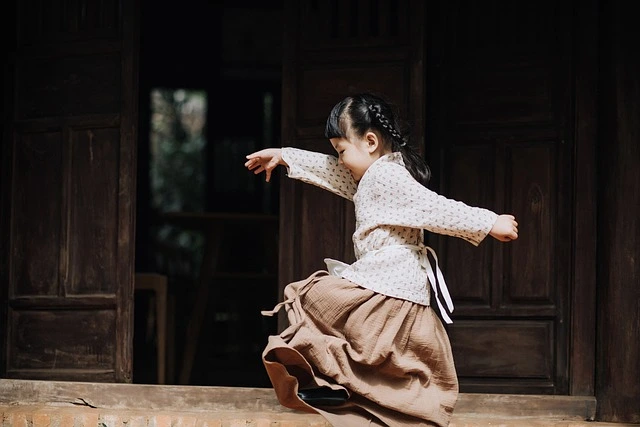It is thought that 95% of cognition occurs in the subconscious mind, whereas only 5% occurs in the conscious mind. This alludes to the fact that the majority of the time, we are running blind, taking action and reacting to circumstances based on programming from our childhood. This could explain why you have emotional outbursts, why you self sabotage, why you continuously face issues in your relationships, and much more.
Personally, when I started to understand what the inner child is, how it affects my current reality, and how I show up in life, everything started to shift. I’d gone to therapy previously, had read about neuroscience and psychology, read countless self help books, did yoga and worked out consistently, but the real shifts started to happen in my life once I started to listen to and heal my inner child. Read more about my personal story here.

The first critical period of brain development occurs between the ages of around 2 and 7 years old. This period of time has lasting effects on human development, where major connections are made between brain cells and synapses are fired and wired. Children are very sensitive and are able to feel deeply, yet do not possess the adult capacity to understand what’s going on in a logical way, and discern what’s rational and what isn’t. Children during this period of development, make conclusions and adopt beliefs based on others’ actions and reactions. Therefore, if a child grew up in a turmoiled environment, was raised by emotionally immature parents, faced any degree of trauma, or felt unsafe, it is likely the child adopted certain “negative” beliefs and developed coping mechanisms, often brought into their adult life.
Basically, we are all children running around disguised as adults. As children, we are sponges, programmed with behavior and actions learnt from our caregivers and from society; and if the people around us possessed unhealthy modes of behavior, we most likely adopted similar ways of acting. This is unless we do the inner child work and cultivate the self awareness to create healthy patterns of behavior and responses that serve us, rather than sabotage us.
Family Dysfunction and its Role in Wounding the Inner Child
Unfortunately, in today’s modern society, there are many “dysfunctional” family dynamics that don’t foster environments for healthy childhood development. According to research conducted by the University of Calgary, unhealthy family dynamics causing children to experience trauma and stress, known as adverse childhood experiences (ACEs), significantly affect both physical and mental health.
Forbes cites that “70-80% of Americans consider their families dysfunctional.” Similarly, a study by the National Institute of Child Health and Human Development (NICHD) discovered that 36% of U.S. children under the age of 18 do not live with both biological parents.
Some examples of family dysfunction include:
- A parent with addictions (drug use, gambling, promiscuity, alcohol abuse, etc.)
- A parent using threat or physical violence to control
- A parent treating a child as an emotional crutch
- A parent unable to provide emotional support
- A parent very focused on outward appearance
- A parent that shames you when doing something ‘wrong’
- A parent that relies on the child to give to them (take care of their emotional needs or siblings needs, a child who pays the bills, etc.)
A child in such a family unit could have experienced a multitude of ‘traumas’ or negative experiences. Some of these can look like:
- Getting locked out of the house
- Getting slapped, hit, or receiving any type of physical abuse
- Getting criticized for their feelings and thoughts
- Parents that were physically or emotionally distant
- Having overly strict parents or parents who provided no guidelines or boundaries
- Preferential treatment amongst siblings
A child can experience physical, emotional, or psychological neglect or any combination of the three, and these can be traumatizing for a child. This lack of safety, real or perceived, from their caregivers can create a multitude of negative reactions brought into adulthood that don’t go away until they are made aware and processed.

Manifestations of a Wounded Inner Child
There are varying degrees of trauma and stress a child experiences, and everyone processes their experiences differently, resulting in many different ways the wounded inner child can manifest and show up in everyday life.
Some common signs of a wounded inner child include:
- Lack of boundaries
- Lack of emotional control
- People pleasing
- Lack of sense of self
- Lack of self love
- Self abandonment
- Self criticisms
- Anxiety or depression
- Unhealthy coping mechanisms
- Disassociation
- Defensive behavior
- Hypervigilance
- Manipulation
- Passive aggression
- Protest behavior
- Substance abuse
- Escapism
- Perfectionism
- Flight of freeze
- Self sabotage
- Fear of abandonment
- Emotional spirals
- Unhealthy relationships
There are many more ways the wounded inner child can show up. The ones listed here are just some of the major ones we can experience. The point is, a lot of our so-called perceived “negative” or self sabotaging behaviors most likely stem from our childhoods, and from what we observed and learned from our caregivers.
How a Wounded Inner Child Affects Relationships
Relationships are a huge learning ground for development, and most of the time, shed light on where our wounded inner child is hurting and needs reparenting. If you’re consistently having difficulties in your relationships, particularly romantic or close familial relationships, this could be an indication that your inner child is asking for help.
In my early twenties, I faced issues in all of my romantic relationships, and while I blamed my partners, I had to eventually come to the realization that I was the issue. I would push away my partners and then try to pull them back, feel super angry one minute and then extremely anxious the next. I never understood what was going on in my internal world, and I was forced by my anxiety to try to understand what was going on internally. This led me to discovering attachment styles, and I came to learn I had severe anxious attachment.
While attachment styles are another concept we can dive deep into, for now, it’s important to understand they are intimately connected to your inner child experience. Coined and developed by psychologist John Bowlby, and later further explored by Mary Ainsworth, attachment styles are how we show up in and around relationships and how we interact in them.
There are four attachment styles:
- Secure
- Is comfortable expressing emotions, doesn’t fear being alone yet thrives in relationships
- Developed from consistent parenting, where parent was emotionally and physically available, and responded to child’s needs
- Anxious-Insecure
- Is often anxious in the relationship, has a fear of abandonment, and seeks support and responsiveness from their partner
- Developed from inconsistent parenting, where child felt nurtured one minute, and neglected the next
- Anxious-Avoidant
- Is often avoidant in the relationship, believes they don’t need a partner, avoids emotional closeness, doesn’t like to be emotional,
- Developed from emotionally unavailable parent
- Disorganized | Fearful- Avoidant
- Is both anxious and avoidant at the same time, and wants intimacy, but is also fearful of it
- Develops when parent becomes a source of fear for the child

Attachment styles are developed during childhood, with the child’s primary caregiver(s) and manifests in relationships throughout adulthood. It’s helpful to understand your attachment style and become aware of how you show up in relationships to move towards a more secure attachment style. Through the discovery of your attachment style, you can also learn to understand how your caregiver(s) showed up for you, heal the wounds and come to forgive and let go of the pain created for you as a child.
Powerful Tools to do Your Inner Child Work
The first step to healing your inner child and doing the inner child work is awareness, and acknowledging that you have a wounded inner child. Once you understand your inner child and start listening to their pain, you can start to use some tools to re-parent and soothe.
Write Letters
Writing letters to and from your inner child is immensely helpful, as it allows you to organize your thoughts, your feelings, and helps you to lay things out more clearly. Be gentle with your inner child, and speak to them like you would speak to someone you love.
It’s also helpful to write letters to your caregivers. Be as honest and open as you’d like in these letters. Express anger and frustration if need be. Let all the emotions out that you were unable to express to them when you were a child. If it feels good, you could later burn the letters as a way of letting go of your bottled up emotions towards them.
In addition to writing letters, journaling and free writing can be great tools to heal your inner child. Whenever you feel like expressing yourself, grab a pen and paper and freely write down your thoughts and feelings. Journaling can be extremely cathartic, and it’s a private exercise that is personal and sacred to you.
Visualization
Visualizations can be a very powerful tool for visiting and healing your wounded inner child. You can visualize yourself as a child, or even revisit childhood experiences if it feels okay with you, and you can speak to your inner child and care for them as your adult self, who knows what you need(ed), is able to regulate emotions and self-soothe.
For visualization exercise, make sure you find a comfortable, safe, and quiet space, where you can be alone for a while. Create a beautiful energy where you feel comfortable visiting your inner child and feel at peace.

Meditation
Meditation is a very valuable tool that you can apply to your everyday life or whenever you’re feeling overwhelmed, want to sit with your thoughts and just understand what’s going on internally, or when you just want to sit quietly with yourself.
There are many methods of meditation, including guided meditations, vipassana meditation, zen meditation, transcendental meditation, mantra meditation, and much more. Find one that resonates with you. There are many free meditation resources offered online for you to explore.
A simple, helpful meditation is one where you simply focus on your breath. Feel the sensations of your breath either in your body, your chest, lungs, rib cage, or the sensations of breathing underneath your nostrils. If you notice thoughts that come up, acknowledge them, then come back to your breath.
Meditation practice helps you recognize what thoughts appear, and helps you build more self awareness on what’s going on internally, helping you hear and quiet your inner voice and critic.
Affirmations
Affirmations are another great tool for healing your inner child. They are positive statements that can help change your negative beliefs and thoughts. Create affirmations that are meaningful, realistic, and helpful to you personally.
Some affirmations include:
- I am proud of my growth
- I am learning everyday
- I am on my own personal journey
- I am worthy of love
- I forgive myself for what I did in survival mode
- I am safe with myself
- I am worthy of abundance
- I am healing day by day
Affirmations can change negative thought patterns and help people feel more safe, more confident, and feel more at peace. However, it’s important to really feel your affirmations and believe what you’re saying.
Somatic movement, in combination with affirmations, are particularly helpful. Doing yoga, engaging in ecstatic dance, or breathwork in combination with affirmations can be especially powerful.
Somatic Movement | Somatic Therapy
Movement is a key tool in healing, and psychologists are discovering more and more the connection between the body and the mind. Somatic therapy is a body-centered therapy that examines the connection of mind and body.
According to Frontiers article, “the vagus nerve represents the main component of the parasympathetic nervous system, which oversees a vast array of crucial bodily functions, including control of mod, immune response, digestion and heart rate)
The Somatic Movement Center further explains that “the nerve fibers that control all of those functions only make up about 20% of the fibers in the vagus nerve. The other 80% of vagal nerve fibers are afferent, meaning that they send sensory information from the organs back to the brain.”
This alludes to the fact that the mind-body connection is very real, and one can influence the other and vice versa. That is why movement is a very valuable tool for healing and promoting homeostasis and a sense of calm.
Yoga, some forms of meditation, and breathwork are extremely powerful somatic tools for releasing certain negative beliefs, and healing your inner child.
Embody Confidence and Enact Boundaries
Healing your inner child is a process. It isn’t easy, it takes a lot of energy and work, however, it’s so worth it. Once you recognize and start healing your inner child, life becomes easier. You know yourself better, you understand your actions and reactions better, and show up healthier in your relationships.
If you’ve struggled with confidence and self worth, you learn to gain and embody confidence, truly loving yourself for who you are, and you stop blaming yourself for certain patterns of behavior. You learn boundaries, including when to say no, expressing how you feel with confidence, not worrying or being fearful of hurting other people’s feelings in place of your own.
You learn to recognize when you’re triggered, understand why you’re being triggered, and slowly start to respond in healthier ways. You’ll also start attracting the people that are aligned with your true self, and start living authentically.







Leave A Comment